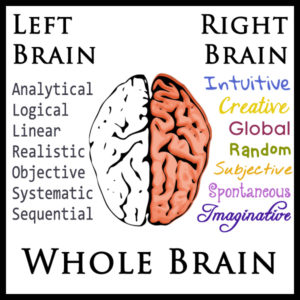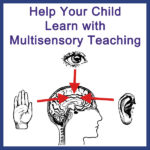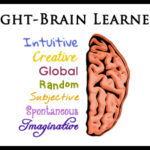
As you probably already know, your brain is made up of two hemispheres. While you typically use both together to accomplish your daily tasks, each side actually has its own specialties.
As the image at left shows, the left hemisphere is analytical and the right is global. One uses logic and the other intuition. One helps you to plan and the other encourages you to be spontaneous.
While the two sides seem diametrically opposed, generally speaking, neither is better than the other. God gave you both sides for a reason. There are situations you’ll run into when your left hemisphere will be useful and likewise your right will be handy in others.
When it comes to learning, each side has its own way of functioning. For example, the left side likes to learn sequentially using a parts-to-whole approach. The right side, on the other hand, prefers a holistic method which first looks at the whole and then the parts.
Many people favor the use of one side of the brain over the other. It isn’t that they don’t use the other side, because they actually do. It’s just that they tend to lean toward their dominant hemisphere in many learning situations, especially those which are difficult. Persons who like to use the left side of their brain are known as left-brain learners. Those who prefer the right are right-brain learners.
Some people are proficient at using both sides of their brain. They are referred to as whole-brain or middle-brain learners. They have the potential to be optimal learners since they can use the side of the brain that works best for a particular situation. However, these people sometimes need a little time to choose the best method for learning a task.
When teaching your child, it’s a good idea to know which hemisphere is your child’s area of dominance (if any). Since it is possible that that portion of his brain may have developed more neural connections, learning will most likely take place faster using that side. Also, it is very likely that your child’s specific talents are tied to that dominant hemisphere.
You can find an assessment for determining hemispheric dominance in this article on the Scholastic website.
Remember this when teaching your child, you don’t want to entirely ignore the other area of the brain. As I said before, God had a greater purpose in mind when he provided us with two uniquely different sections of our brains. We are supposed to have both ready for use at a moments notice when interesting circumstances come waltzing across our path. Therefore, teach to your child’s dominant hemisphere, but don’t be afraid to let him dabble on the other side of his brain once in a while, especially when that side provides a better technique for accomplishing some task or goal.
To learn more about the specific characteristics of left-brain and right-brain learners as well as effective methods for teaching them, click on the links below:







What a wonderful interesting read. I think My eldest is more right brained, as he’s very creative, my middle is left brained. I must remember this when helping them with their learning.
I’m glad you found this helpful.